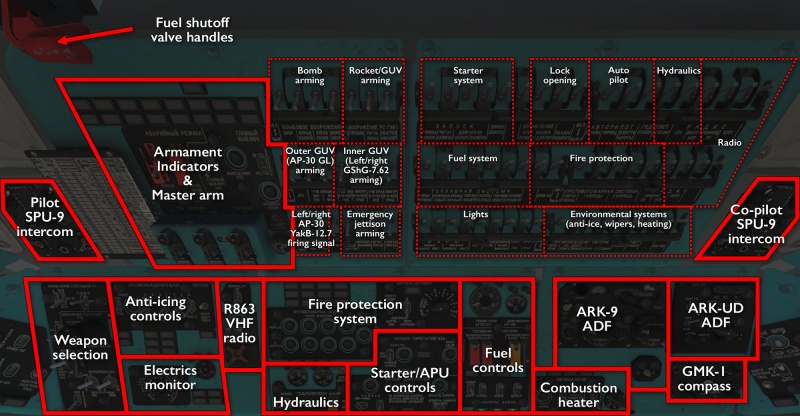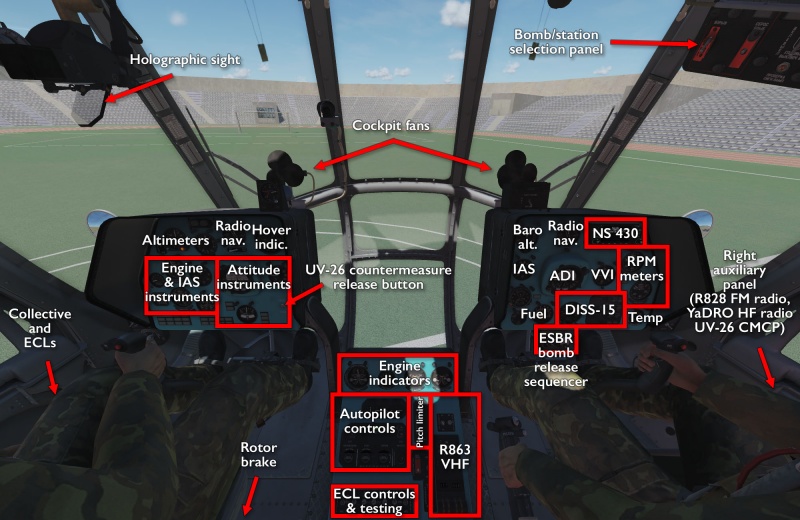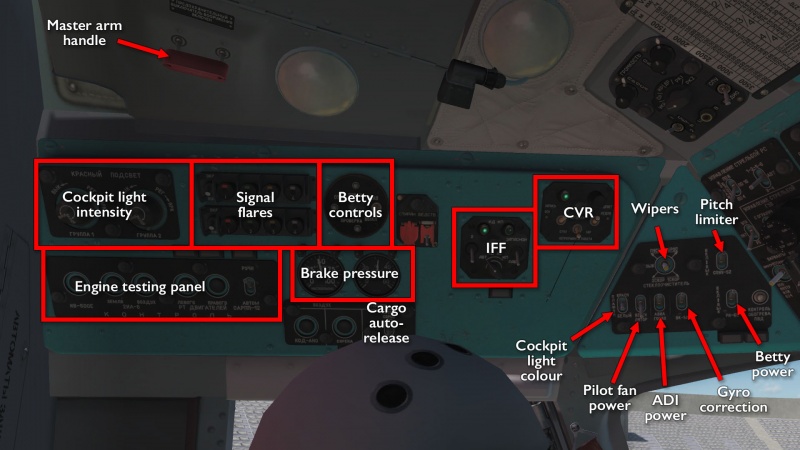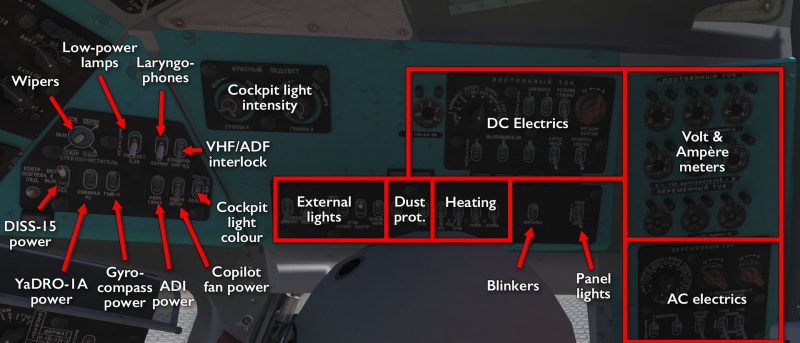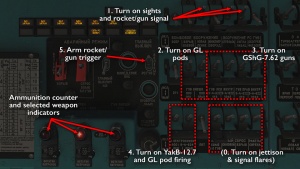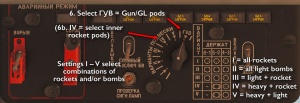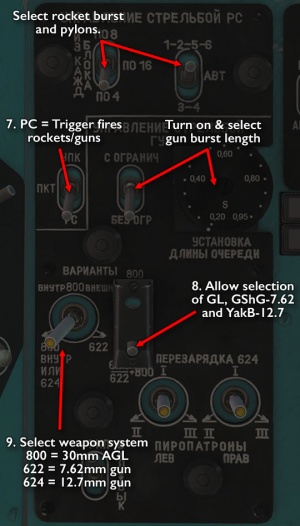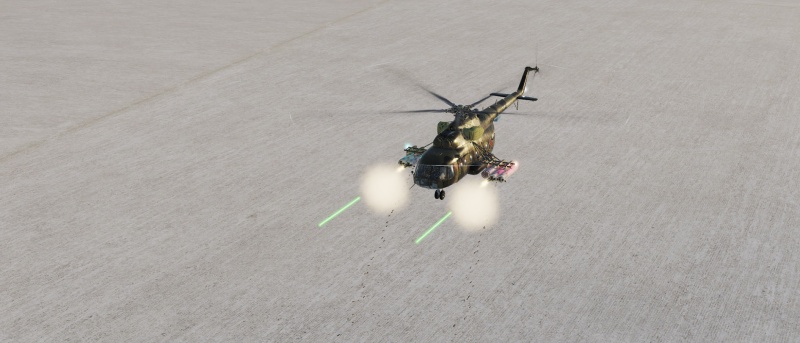Mi-8MTV2 Magnificent Eight
Take your average inner-city commuter bus. Now strap two honking great engines and an even greater and more honking rotor to it. Then strap rockets to it. No, more rockets. Oh, and go to your local CB:s-Я-Us switch wholesaler and buy out their entire stock to use as interior decoration. Congratulations, you now have yourself an Mi-8MTV2 — the not-yet-militarised version of the Mi-17 Hip, and one of the most common helicopters in the entire world.
In the DCS world, it is not quite as common because it is, after all, simply a very large transport helicopter that you just so happen to be able to strap some weapons pods onto. The bus comparison is a bit unfair — the Mi-8MTV2 can be a surprisingly fast and agile helicopter — but the engine and rotors that gives it that speed and agility are work horses. They are built to haul heavy loads over long distances, not to duck and weave in tight spaces, and they are slow to respond to throttle and collective inputs. The simile is more that of a 1500+ Hp diesel engine than a 500Hp V8.
Features
The Mi-8MTV2's core task of “go to place; drop off stuff” is readily apparent when looking at its feature list:
- Five different radios (R-863 VHF, R-828 FM, YaDRO-1A HF, ARK-9, ARK-UD), most of which are used for direction-finding and homing rather than for communication.
- DISS-15 doppler navigation and hover/drift indication.
- A subtly competent autopilot.
- Semi-automated cargo slinging, including a special cargo view to spot your pick-up and drop-off point.
- Roughly four bajillion circuit-breaker switches.
- Enough panels and things to monitor to occupy a crew of three (pilot, co-pilot, flight engineer), but no way of multi-crewing it so you have to manage it all by yourself.
- More rockets, grenades, and miniguns than you could possibly ever need, and also bombs and auto-cannons.
Comes with the built-in Spring Tension campaign.
Flying the Mi-8MTV2
Flying the Mi-8MTV2 can be summed up in three letters: R, P, and M. This little bird bus lives or dies by the pilot's ability to maintain a steady high RPM by not asking the engine to do too much at the same time. The two TV3 engines can deliver a lot of power but will require time to do so, and will drop RPM if they get behind the curve. Dropped RPM, in turn, means a loss of electric power from the generators, and a loss of lift from the rotors.
This loss of electricity (and consequently of powered pilot aids) and the loss of lift will easily combine into a very disorganised ride down, but the aircraft can usually power out of it if enough speed, altitude, or just plain old time is available for the engine to sort itself out. Unfortunately, such a loss of RPM usually originates from the simultaneous and numerous high demands that come from take-offs and landings — situations where speed and altitude are low, and you do not have a whole lot of time until the trees grow uncomfortably large outside the cockpit windows.
The upside is that the Mi-8MTV2 is most commonly employed from airfields where it can employ running take-offs and landings. This means it can build up speed (or not slow down) while also having to worry about maintaining altitude, which bypasses the whole problem almost entirely. Even when low speed or hover transitions are required, the airframe will give ample warning that things are about to require extra attention. It goes through a period of significant and noisy cockpit shudders at around the 80km/h IAS mark as it starts to lose translational lift — this is an unmistakable signal that some proper RPM management is required.
Cockpit overview
The first thing that usually strikes a new pilot stepping into the Mi-8MTV2 cockpit is that someone seems to have shotgunned the ceiling with circuit-braker switches — indeed, any time anyone talks about this module, it is likely the first thing that will come up.
In spite of that first impression and reputation, however, the Mi-8MTV's cockpit is very well-organised and sensibly laid out. The infamous CB:s are clustered in clear groups, and the pilot, co-pilot, and flight engineer have direct and easy access to the things they should be dealing with: the pilot controls the flight instruments and the sling-loading; the co-pilot handles navigation and communication; the flight engineer monitors engines and electrics from the centre console and the side consoles. Most of those imposing rows of switches are flipped en masse at the very beginning of the start-up procedure and then never touched again.
The one major exception is the employment of weapon systems, which is… a mess. The controls for them are still grouped, of sorts, but are still spread out to the point where all three crew members have to get involved before anything aggressive goes flying down-range. The co-pilot has to decide which pylons get the firing signal. The engineer has to make sure the systems are powered. The pilot has to select the appropriate system to fire, and set it up in a less than transparent way.
While the layout is reasonably good and logical, that exception aside, it is generally advisable to get a high-quality cockpit livery for a language that the pilot understands, since finding the right switch or button can be a bit messy otherwise. Two particularly good arguments for this slight modding are the start and fire protection panels, where, in the first case, there are multiple ЗАПУК (Start) buttons and switches where the correct order is obvious if you read Russian and anything but if you do not. In the second case, flipping one innocuous switch at the wrong time can disable the entire aircraft because now the engine is full of extinguishing fluid — not understanding the label that says so can make for some embarrassing moments.
Getting into the air
As with many other full-sim DCS aircraft, getting the Mi-8MTV2 stared can be a long process, but unlike most of them, this is not because of some complex systems that need to be initialised — instead, there's simply a lot of stuff to turn on, and doing it out of order can overload the electrical system or run down the batteries in very short order.
As is often the case, there is a RWinHome “cheat” keyboard shortcut that runs through the startup process for you, but in the case of the Mi-8MTV2, it is actually somewhat unreliable. There are a number of outside parameters, such as wind and temperature, that can alter the timing of how the engines get going that the script might simply fail to do so. There are numerous good guides and checklists that run you through the process, though, and the module itself even comes with a built-in one — the main steps are listed on the kneeboard, and you can make an AI copilot run through the list for you, telling you what to do next.
The full procedure is far too long to describe here, but the general gist of it is:
- Making sure wheel brakes are on and the rotor brake is off.
- Turning on batteries and inverters.
- Turning on all the circuit-brakers on the left side of the ceiling using the handy lifting tabs.
- Turning on fire protection.
- Turning on fuel and boost pumps, opening fuel shut-off valves.
- Putting the APU into starter mode and pushing its start button, then waiting for it to spool up.
- Turning on the engine starter, selecting an engine, and pushing the engine start button.
- Move the fuel shut-off lever in the ceiling forward as the engine spools up.
- Repeating the process for the other engine.
- Throttling up once both engines are up and running.
- Turning on generators, inverters, and rectifiers now that there is something to produce AC power.
- Using that AC power to turn on any remaining systems one might want to use.
- The usual helo stuff of ground trimming to avoid uncontrolled tipping over or yawing, and then making your way to the runway… or try a vertical take-off because rolling starts are for the feeble.
Shooting something
The Mi-8MTV2 is first and foremost a transport and lifting helicopter, but obviously, this means that it can lift a downright obscene amount of weapons — some of them can even be made to fire in a reasonably appropriate direction. The process for getting there is fairly complicated, however, and can get really mind-bending if you bring along bombs and need to figure out the right sequencing to have them drop in the right order.
More commonly, the Mi-8MTV2 is equipped with a combination of rockets and gun/grenade pods, and the layout of the controls make it readily apparent that this is indeed intended to be on of, if not the most obvious loadout. The process for getting everything going requires all three crew-members to do something at their respective stations:
- The engineer has to power the weapon systems and arm the trigger.
- The co-pilot has to select the appropriate weapon pylon and firing signal.
- The pilot has to select the specific weapon system, and do the actual flying, aiming, and firing.
This is perhaps the most readily obvious scenario that illustrates that, switch frenzy notwithstanding, there is a logic — if perhaps an obsessive need to control specific details — to how the systems are laid out. Let us, for instance, try to ready that standard loadout.
The engineer's job: activating the systems
Dive into the rightmost portion of the overhead maze of switches and turn on the ones that control the weapon systems you are carrying (or just all of them because it does not actually hurt to do so).
- Turn on the general armament controls.
- Turn on the left and right AG-17 grenade launchers (800 ЛЕВ, 800 ПРАВ).
- Turn on the individual left and right GShG-7.62mm guns on the left and right side (ЛЕВ/ПРАВ 622 ЛЕВ/ПРАВ).
- Turn on the firing electrics of the left and right AG-17 and YakB-12.7mm guns (ЕЛЕКТРОСПУСК 800; 624 ЛЕВ/ПРАВ).
- Arm the rocket/gun trigger (РС ГУВ).
The co-pilot's job: selecting the pylon
Below the co-pilots triangular panel hangs the bomb control panel, which, as one might suspect, controls bombs, rockets, gun pods, and selective jettisoning… A handy little table shows off which modes on the dial activate which pylons for the purpose of using a specific weapon type. The most important ones are usually the ГУВ setting, which selects gun pods, and position IV (or position I), which activates rocket pods on the inner pylons. Thus:
- Turn the selector dial to ГУВ.
The pilot's job: selecting the weapon
Links and files
- Tippis' Checklist (see also kneeboard mods).
- Chuck's Mi-8MTV2 guide.
- DCS: Mi-8MTV2 Magnificent Eight by Belsimtek in the DCS shop.
Related DCS modules
- NS 430 Navigation system for Mi-8MTV2.
- The Border Campaign for Mi-8MTV2.
- The Oilfield Campaign for Mi-8MTV2.
More information
| DCS World | |
|---|---|
| Helicopter modules (full sim) |
Ka‑50 Black Shark 2 · Mi‑8MTV2 Magnificent Eight · Mi‑24P Hind · SA342L, M, Mistral, and Minigun Gazelle · UH‑1H Huey |



